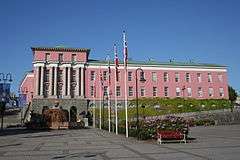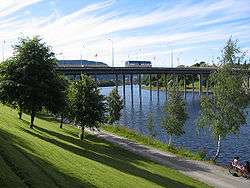Herman Munthe-Kaas
Herman Munthe-Kaas (25 May 1890 – 5 May 1977) was a Norwegian architect. He was primarily known for his functionalist building designs.[1]



Biography
Munthe-Kaas was born at Christiania (now Oslo), Norway. He was the son of Marius William Munthe-Kaas (1856-1926) and Hermine Cathrine Blichfeldt (1863-1937). Munthe-Kaas graduated from Kristiania tekniske skole (now Oslo University College) in 1910 and Norwegian National Academy of Craft and Art Industry (Statens Håndverks- og Kunstindustriskole) in 1912. He apprenticed with Arnstein Arneberg from 1916-18. In 1918, Munthe Kaas attended the Royal Institute of Technology in Stockholm and during 1919-20 the Academy of Arts in Copenhagen. [2]
Together with Gudolf Blakstad, he started the architectural firm Blakstad og Munthe-Kaas Arkitekter in 1922. The firm discontinued a few years after Gudolf Blakstad death in 1989. The firm collaborated on several significant assignments in Norway including Kunstnernes Hus for which they were awarded the Houen Foundation Award in 1931.[3] [4]
Their work also included the City Hall in Haugesund (1931), Elgeseter Bridge (1951) in Trondheim, Bodø Cathedral (1956) in the Diocese of Sør-Hålogaland and Alfaset chapel (1972) in Oslo.[5]
See also
References
- "Herman Munthe-Kaas". lokalhistoriewiki.no. Retrieved October 1, 2017.
- Espen Johnsen. "Herman Munthe-Kaas". Norsk biografisk leksikon. Retrieved October 1, 2017.
- "Blakstad og Munthe-Kaas Arkitekter". Kunsthistorie. Retrieved October 1, 2017.
- "Houens diplom. 1931. Kunstnernes hus. Gudolf Blakstad og Herman Munthe-Kaas". lokalhistoriewiki.no. Retrieved October 1, 2017.
- Bjørn Cappelen. "Herman Munthe-Kaas". Store norske leksikon. Retrieved October 1, 2017.
Other sources
- Grønvold, Ulf & Jiří Havran (2000) Priset arkitektur 1904-2000: bygninger belønnet med A.C. Houens fonds diplom (Oslo: Arkitekturforlaget) ISBN 82-7532-014-3